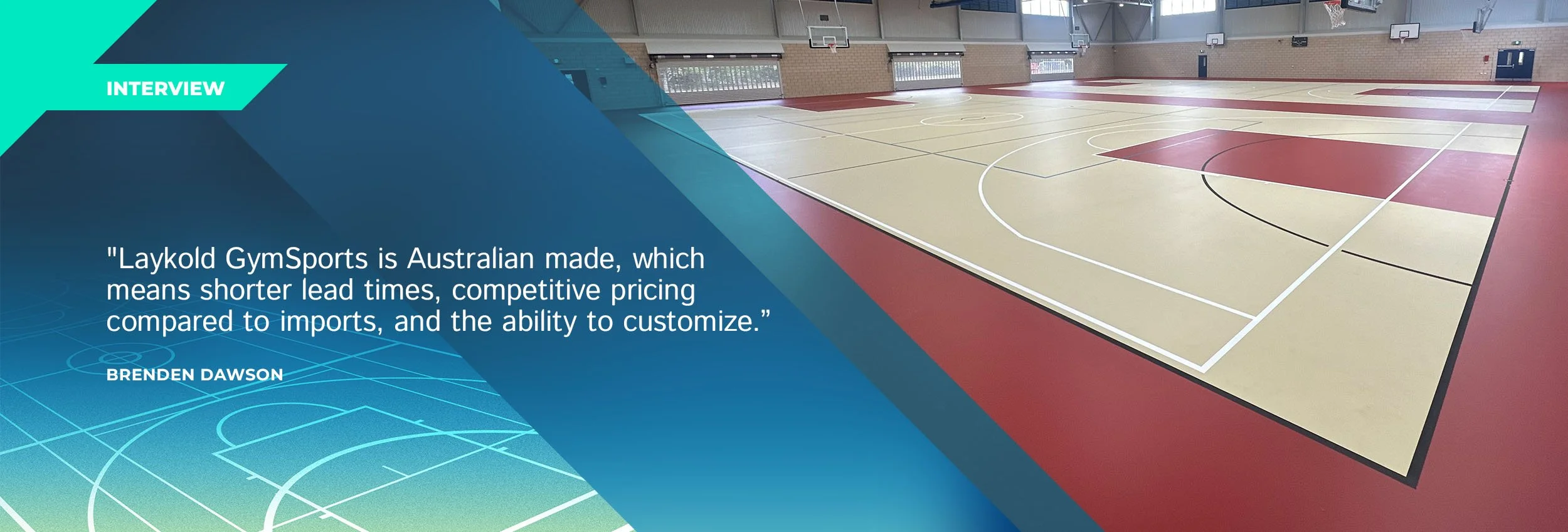Interview: Brenden Dawson, Managing Director, GrasSports Australia (Queensland)
How Laykold GymSports is helping to grow business and sports participation in Australia.
GrasSports Australia has been building and maintaining sports facilities since 1964, from outdoor tennis courts to synthetic pitches. In Queensland, the business has become a leader in indoor sports flooring, particularly with the adoption of Laykold GymSports.
We sat down with Brenden Dawson, Managing Director of GrasSports Australia (Queensland), to talk about the evolution of the industry, the unique challenges of building for Australia’s climate, and why Laykold’s GymSports has become a trusted solution.
Miami State High School
How did you get into the sports industry and eventually GrasSports?
I grew up on the Gold Coast here in Queensland. My father ran a fencing company, and through him, I started with tennis court fencing.
I studied drafting and engineering but decided I didn’t want to stay in an office. I came back into the sporting industry, and when my father sold the business, I joined Bernard Evans from GrasSports to establish a Queensland division. Today, GrasSports operates in Victoria and Queensland, and we’ve just opened in Tasmania.
Helensvale State High School outdoor courts
Tell us a bit about GrasSports and the Australian sports landscape.
We specialize in synthetic sporting facilities and recreational areas. That includes soccer, futsal, hockey, cricket nets, netball, and basketball – along with hard courts and indoor polyurethane surfaces.
In Australia, sport is huge and schools in particular are lifting their standards. It used to be that every school had two outdoor hard courts. Now it’s often two or four outdoor courts plus an indoor facility. And that shift is driving demand for higher-quality indoor surfaces.
How did indoor installations become part of your business?
Queensland’s climate plays a big role in that. Timber floors don’t perform well in tropical conditions because they warp and expand. Around 10 years ago, demand for polyurethane flooring grew, especially in cyclone shelters and community centers.
We brought in Mick Duggan, Factory Manager (Coatings) from APT (Advanced Polymer Technology) to educate our team, and since then we’ve been steadily increasing our indoor projects. Ten years ago it was one a year; now we’re doing five or six annually.
“There’s a clear expectation now that secondary schools will have an indoor sports facility. Local councils and community centres are also investing more, as sports like basketball, netball, volleyball, and badminton continue to grow.”
What makes indoor hardcourt sports different in Australia compared to overseas?
Climate and humidity are the biggest factors. In tropical areas like Queensland, products cure faster, so we get less working time during installation compared to somewhere like Melbourne or overseas in cooler climates. You have to adapt to those conditions.
Another difference is cost. Sprung timber floors are still seen as the “elite” surface, but they’re very expensive and usually imported from North America. Polyurethane floors like Laykold GymSports are far more cost-effective, especially in regions where humidity makes timber difficult.
Miami State High School - installation
Are you seeing more schools and councils invest in these facilities?
Definitely. There’s a clear expectation now that secondary schools will have an indoor sports facility. And local councils and community centers are also investing more.
Funding is part of it, but it’s also about meeting participation demand. Sports like basketball, netball, volleyball and badminton are growing, and facilities need to cater for large groups of students year-round.
Helensvale State High School
What types of installations are you doing most often?
Mostly schools – both state and private – and community centers. Every facility is multipurpose. A single court will usually have at least four sets of line markings: basketball, netball, volleyball and badminton. Larger venues can have multiple volleyball or badminton layouts on top of that.
When did you first start working with Laykold?
I first worked with Laykold around 2006 on outdoor hardcourts. In Queensland there’s been a clear shift from synthetic grass to hardcourts, especially with the influence of the Australian Open.
For indoor GymSports, we’ve been working with Laykold for about 10 years. We’ve seen a lot of growth and confidence in the brand.
What qualities make Laykold GymSports well-suited to the Australian market?
A few things stand out. It’s Australian-made, which means shorter lead times, competitive pricing compared to imports, and the ability to customize. We developed a tomato red and ivory court for Palm Beach High school to match their school colors, which was something we could turn around quickly because it was produced here.
And it’s durable and multipurpose. Schools need courts that can handle basketball one day, volleyball the next, and an assembly the day after. Laykold GymSports goes the distance and delivers on performance.
It’s also about relationships. Working directly with the team in Melbourne means we can collaborate and know support is there.
Do you have a favorite project?
Palm Beach High School really has the “wow” factor. Their bespoke red-and-ivory court was also certified for international badminton competition, which just goes to show the level of quality we can deliver.
Our team behind the installations make a huge difference to these projects. Guys like Kyle Williams, our lead applicator, and Aaron Sprott, our project manager, are the ones out there delivering. Without them, GrasSports wouldn’t be where it is today.
Palm Beach High School

